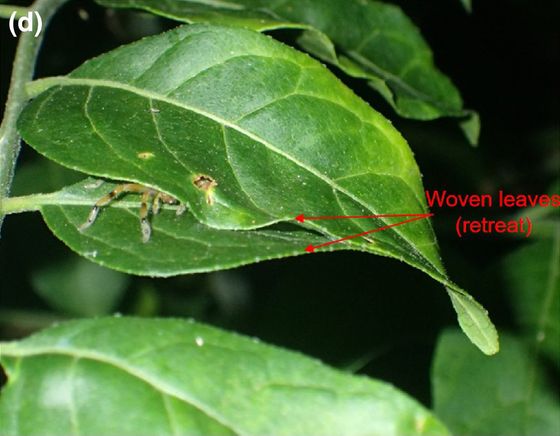Spiders may be making 'traps to catch frogs'

Spiders that live all over the globe can prey on not only insects but also small birds and mammals. 'The annual predation of spiders around the world is heavier than the weight of all human beings on the planet. There is also a
Spider traps amphibian in northeastern Madagascar --Fulgence ---- Ecology and Evolution --Wiley Online Library
https://onlinelibrary.wiley.com/doi/10.1002/ece3.7102
Huntsman Spiders Have Been Found Weaving'Frog Traps' Out of Silk And Leaves
https://www.sciencealert.com/frog-hunting-spiders-in-madagascar-found-using-cool-leaf-traps-to-lure-prey
Huntsman spiders may sew leaves into fake shelters to lure frogs | Science News
https://www.sciencenews.org/article/hunstman-spiders-leaves-fake-shelters-frogs

Spiders spit out strong and supple threads to form net-like nests that prey on insects caught in the nests. Spider predators include not only insects, but also small mammals and reptiles that get stuck in their nests, and in the past it has been reported that spiders have captured birds and snakes larger than themselves. ..
The newly published paper is a `` case where a spider captured a frog'' discovered during an ecological survey of northeastern Madagascar from 2017 to 2018 by research teams at the University of Göttingen in Germany and the University of Antananarivo in Madagascar. I am reporting about.
During an ecological survey, the research team discovered four 'structures in which two leaves were attached with spider silk to form a pocket.' In one of them, a frog wrapped in thread was found in a pocket-shaped leaf.
The photo below is a photo of a 'frog captured by a spider' actually discovered by the research team. You can see that there are a frog and a spider wrapped in thread inside the two leaves pasted with thread. Spider huntsman spider , which is a kind of ' Damastes sp. ' Is a kind of frog is an endemic species of Madagascar Island Heterixalus andrakata (Andorra Kata Hishime grasses Gael) thing with it.

The research team first discovered a frog-captured 'structure in which two leaves were attached with a thread to form a pocket' in a 2017 survey, and three similar structures were found in a 2018 survey. I heard you found it. 'We were very excited when we first saw this phenomenon,' said Thio Rosin Fulgence, an ecologist at the University of Antananarivo.
The Andorra katahishimekusagaeru is a small frog with a body length of about 2 to 3 cm, and although it mainly lives on trees, it hides between the leaves during the day to avoid drying out. The structure found this time is a perfect hideaway for frogs who want to avoid the heat, and Fulgence and others think that it may be a 'trap made by spiders to catch frogs'.
Science Alert, a scientific media outlet, said the findings were based solely on observation, 'for fairness, it's uncertain to call them traps for frog capture.' Stanislav Pekár, a bioethologist at Masaryk University in the Czech Republic, who was not involved in this study, said that the leaf-attached structure is not a trap, but simply a place where the spider itself hides and ambushes its prey. It states that there is a possibility.
Meanwhile, Jose Valdez, a conservation biologist at the German Center for Comprehensive Biodiversity Research, who is not involved in research like Pekár, acknowledges that the structure may be a spider's hideout, but spiders do. I point out that I am curious about the reason for making such a structure. 'I think there's an easier place for these spiders to hide in the woods,' he said, arguing that he dares to speculate that there are other reasons for spiders to stick leaves into pockets. did.

Although spiders have been reported to prey on amphibians in the past, they were accidental and were not believed to have been specialized in catching frogs. However, from the case found in Madagascar this time, 'I speculate that amphibians may not only be accidental prey, but also a systematic source of food for the Damastes sp.', The research team said. I am.
Related Posts:







